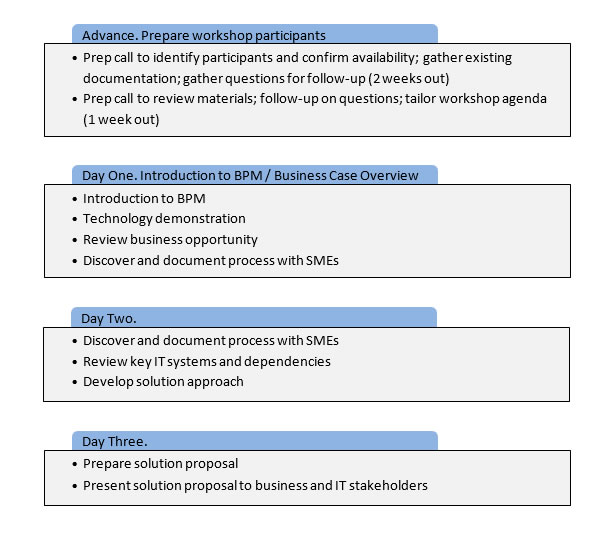Workshop agenda

Preparing workshop participants
Schedule a prep call or meeting at least two weeks in advance to verify availability of all required participants. Review the business context, existing documentation, and process models. Gather questions and assign to participants to gather additional information. Give information-gathering assignments, and finalize the workshop agenda. If additional data is required, or if one or more participants are not available, reschedule the workshop. Never schedule the workshop without the process owner and SMEs. Without an empowered decision maker and the experts in the workshop, the output of the workshop is less than useful.
Introducing BPM
For workshop participants who are new to BPM, provide an overview of BPM and the tools of IBM Business Process Manager with a demonstration in a 1 - 2 hour discussion and presentation. Kick off the workshop with a review of the business opportunity and outline the business value case for this process area.
Discovering and documenting the process
Engage participants in a hands-on collaborative workshop in Blueworks Live. The workshop leader provides basic guidelines of good process modeling. This activity occupies 1 - 2 days, or most of the workshop time, in 3 - 4 hour sessions with the process owner and SMEs.
Model for discovery first, but also keep the model “theoretically implementable” as you go. This situation means allowing participants to brainstorm and tell their stories and capture them as told, but refrain from documenting proposed “I want” activities that you know are not feasible.
Document key performance indicators (KPIs), success metrics, and pain points for the project. These items start small but should quickly become relevant to your enterprise value chain.
Use the Suppliers, Inputs, Process, Outputs, Customers (SIPOC) method for defining the business details for each activity in the process. Blueworks Live incorporates SIPOC, so make use of it to start building process inventory.
Determining scope and complexity
Perform a rough count of steps (activities and subprocesses), participants (swim lanes), user interfaces (coaches), system integrations, and business entities (complex variables) to determine the overall complexity of the process. With a fairly complete SIPOC analysis and activity details completed in Blueworks Live, it is easy to determine the complexity of a business process.
Use the analyze tool in Blueworks Live to estimate the complexity of the process as it involves different participants, systems, process owners, experts, suppliers, customers, inputs, and outputs.
Developing the solution approach
A BPM solution architect works with the team to prepare a high-level solution approach to the business problem. It includes a rough order estimate of the number of different business process definitions (BPDs) and the relative number of steps (subprocesses and tasks) in the solution.
The solution architect uses the rough count of the number of system integrations required and the opportunity for trade-offs with system integrations. As you develop a solution approach, you begin to outline the feasibility and cost/benefit analysis of system integration. While some integration decisions might be easy, others might not be decided until implementation begins. The solution should create a shared vision as to how the process might be implemented and a rough-order-magnitude (ROM) estimate for what the implementation might require.
Discussing findings and proposed approach
In the final 3 - 4 hours of the workshop, the process owner, with help from the solution architect, presents the workshop summary to stakeholders. This is a joint presentation mainly from the process owner, as it sets the collaborative tone for the project.
